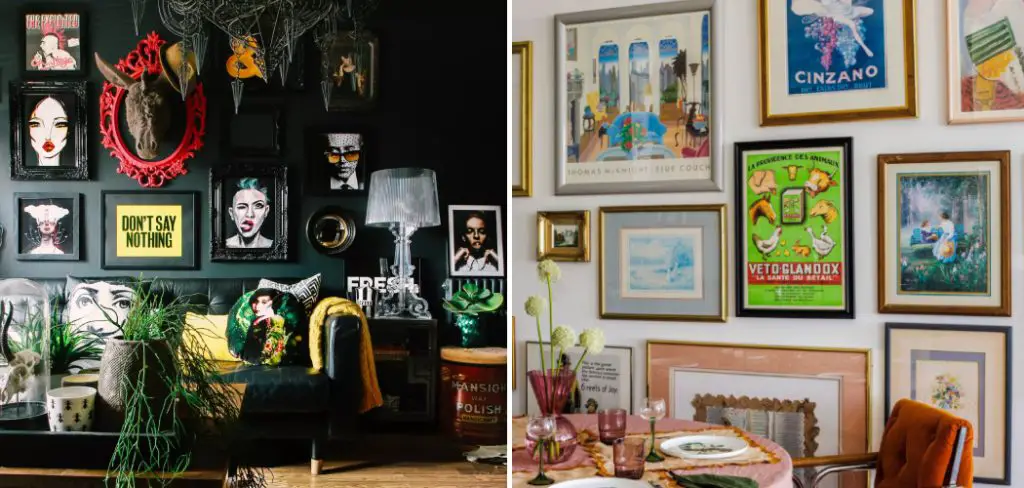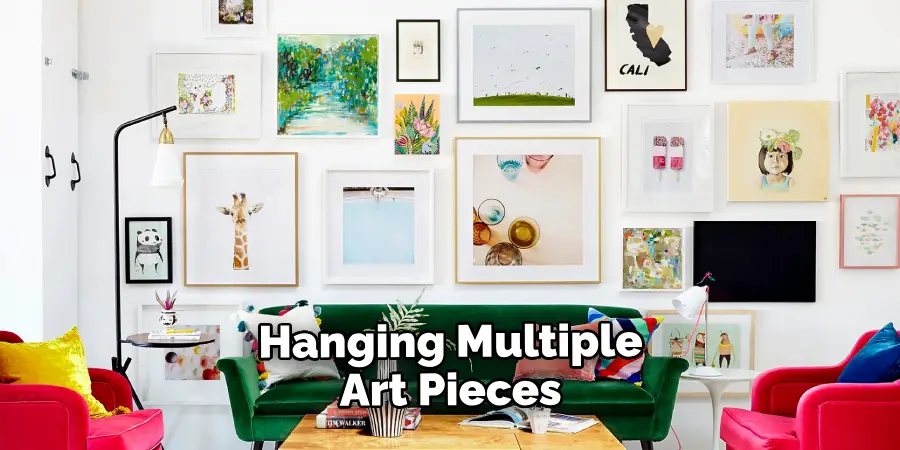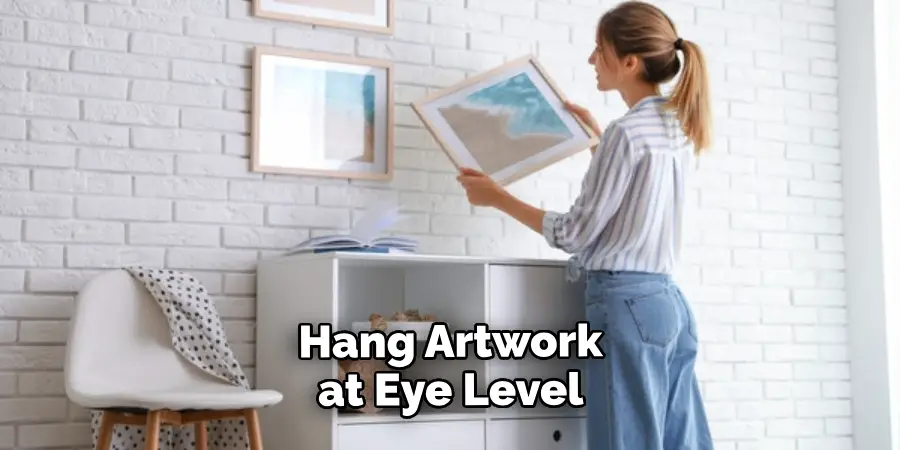Mixing art in a room can enhance the overall aesthetic, create a focal point, and add personality to your space. By carefully choosing and arranging different pieces of art, you can transform any room into a beautiful and unique space. Whether you are decorating your home or office, knowing how to mix art in a room is an essential skill for creating a visually appealing environment.

Art is an integral part of interior design as it adds personality, character, and color to a room. However, incorporating art pieces into a room can be intimidating for many people. The fear of making the wrong choice or creating a cluttered look often holds people back from experimenting with different art pieces in their homes. In this blog post, You will learn in detail how to mix art in a room.
Step-by-step Instructions for How to Mix Art in a Room
Step 1: Inspect the Room
Before you start mixing art, it’s important to assess the room and identify key elements such as wall color, lighting, furniture placement, and other decor pieces. This will help you determine the overall mood of the room and guide your art selection.
Step 2: Choose a Focal Point
Every room needs a focal point, whether it’s a fireplace, large window, or an eye-catching piece of furniture. Once you have identified the focal point in your room, use it as a starting point for mixing art. Are you going for a modern, eclectic, or traditional look? Choose one main style and stick to it when selecting art pieces. This will create cohesiveness and prevent the room from looking cluttered.
Step 3: Determine the Color Palette
The colors in your art should complement the existing color palette of the room. Consider using a color wheel to help guide your choices and create a harmonious balance. Mixing art is all about creating visual interest. Play with different sizes, shapes, and orientations to add depth and dimension to the room.
Step 4: Balance the Placement
When hanging multiple art pieces, balance is key. Avoid grouping all of your large pieces on one side and small pieces on the other. Instead, distribute them evenly throughout the room for a more balanced look. Don’t be afraid to mix different types of art, such as paintings, photographs, and sculptures. This will add texture and variety to the room.

Step 5: Consider Scale
Be mindful of the size of your room when selecting art pieces. A large piece in a small room can be overwhelming while a small piece in a large room may get lost. Make sure there is a balance between the size of the art and the size of the room. Play around with different placements before drilling holes in your walls. Use tape or paper cutouts to visualize how each piece will look in the space and make adjustments accordingly.
Step 6: Mix Old and New
Incorporating vintage or antique pieces into a modern room can add character and personality. Don’t be afraid to mix old and new art pieces for a unique and eclectic look. A gallery wall is a great way to showcase multiple art pieces in one space. This can be done by hanging frames of different sizes and shapes or using shelves to display smaller pieces.
Mixing art doesn’t have to be limited to just paintings and photographs. Consider incorporating sentimental items such as heirlooms, souvenirs, or even children’s artwork to add a personal touch to the room.
Safety Tips for How to Mix Art in a Room
- Before you begin mixing art in a room, it’s important to have a clear plan in mind. This will help prevent any accidents or mishaps while handling delicate pieces of art.
- When hanging art on walls, ensure that the appropriate hooks and hardware are used. Avoid using adhesive materials as they can damage both the art piece and the wall.
- Take note of any electrical outlets or switches before placing any art pieces. You want to avoid hanging anything that may interfere with these fixtures for safety reasons.
- Consider the placement of your art in relation to furniture and walkways. Avoid obstructing pathways or creating potential tripping hazards with larger pieces.
- If you have young children or pets, consider their safety when placing art in a room. Avoid hanging pieces too low or within reach of curious hands and paws.
- When mixing different types of art, ensure that the styles and colors complement each other. Consider using similar frames or spacing out the pieces to create a cohesive look.
- Always handle art pieces with care to prevent any damage. Use gloves when necessary and avoid placing art in direct sunlight or areas with high humidity.

What Are Some Creative Ways to Display Art in a Room Besides Hanging It on the Walls?
Art is a great way to express yourself and add a personal touch to any room. While hanging art on the walls is the most common method, there are many other creative ways to display art in a room. In this article, we’ll look at some unique and unconventional ways to mix art in a room.
1. Utilize Shelves and Ledges
Shelves and ledges are a great way to display small pieces of art or collections. You can arrange multiple shelves at different heights and layer artwork on them for a more dynamic look. This method works well with smaller pieces such as framed photographs or postcards, but you can also use it for larger pieces by propping them against the wall instead of hanging.
2. Create a Gallery Wall
A gallery wall is a popular trend in home decor, and for a good reason. It allows you to mix different types of art in one cohesive display. To create a gallery wall, choose a focal point and build around it with smaller pieces. You can also incorporate various frames and styles for an eclectic look.
3. Use Decorative Frames
Frames are not just for hanging art on walls. They can also be used as standalone pieces to display smaller art or photos. You can place them on a side table or shelf, and even hang them from the ceiling for a unique look.
4. Layer Artwork
Layering is an excellent way to add depth and texture to a room’s design. You can layer different types of artwork, such as paintings, photographs, and tapestries, to create a visually interesting display. This method works particularly well with neutral walls as it adds color and dimension.
5. Create a Themed Display
If you have a large collection of art pieces, consider creating a themed display. For example, you can gather all your travel photos and create a gallery wall that showcases different destinations. You can also group similar colors or subjects for a cohesive look.
6. Utilize Furniture as Display
Furniture can serve as more than just functional pieces in a room. You can use bookshelves, dressers, and even chairs to display art and other decorative objects. This method is particularly useful if you have limited wall space or want to mix different types of art.
7. Hang Art From the Ceiling
Hanging art from the ceiling is a unique and unexpected way to mix art in a room. This works well for larger pieces or collections that you want to display together. You can use various hanging materials, such as fishing wire or rope, to create a floating effect.

8. Incorporate Lighting
Lighting can make all the difference when it comes to displaying art in a room. You can use track lighting or spotlights to highlight specific pieces, or add string lights for a whimsical touch. Proper lighting not only enhances the artwork but also adds ambiance to the room.
What Are Some Common Mistakes to Avoid When Mixing Art in a Room?
While there are many creative ways to mix art in a room, there are also some common mistakes that should be avoided. Here are a few things to keep in mind when displaying art in a room:
- Don’t overcrowd the space. It’s essential to leave enough breathing room between each piece of artwork for them to stand out individually.
- Avoid hanging art too high on the walls. The general rule of thumb is to hang artwork at eye level, but this may vary depending on the room’s layout and furniture.
- Don’t be afraid to mix different styles and mediums. Experimenting with different types of art can add interest and personality to a room.
- Avoid using too many small pieces or cluttered displays. This can make a room feel busy and overwhelming.
- Don’t limit yourself to traditional frames. Consider using unconventional materials such as fabric or old windows for a unique display.

Overall, the key is to find a balance between creativity and cohesion when mixing art in a room. Don’t be afraid to try new things and think outside the box while keeping in mind the overall design of the space.
Conclusion
In conclusion, mixing art in a room can add a unique and personal touch to any space. It allows you to showcase your individual style, interests and personality. However, there are some disadvantages that should be considered.
One disadvantage of mixing art in a room is the potential clash of styles or themes. If not done carefully, the different pieces of art may not complement each other and create an overall chaotic or unbalanced look. This can detract from the intended effect of creating a cohesive and visually appealing space. I hope this article has been beneficial for learning how to mix art in a room. Make Sure the precautionary measures are followed chronologically.
About
Angela is the chief editor of Indoorense. She began her career as an interior designer before applying her strategic and creative passion to lifestyle and home.
She has close to 15 years of experience in creative writing and online content strategy for housekeeping and cleaning,home decorations as well as other efforts.
She loves her job and has the privilege of working with an extraordinary team. She lives with her husband, two sons, and daughter in Petersburg. When she’s not busy working she spent time with her family.

